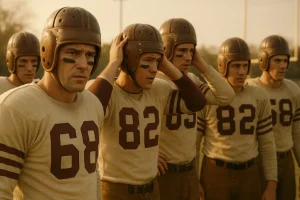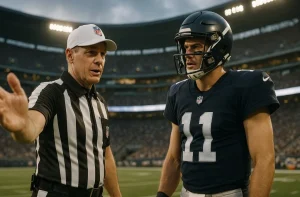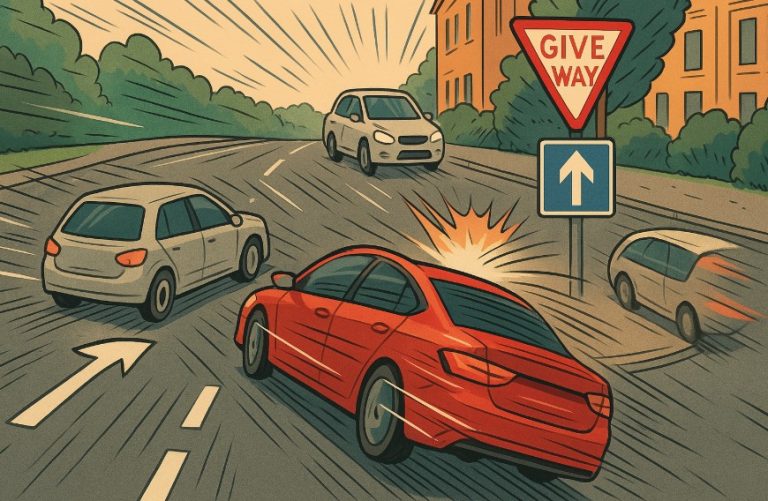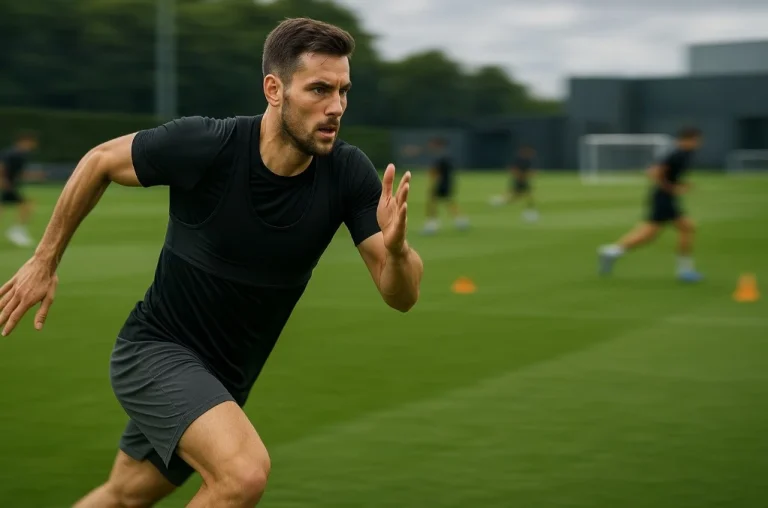What Makes Eye Black a Fascinating Part of American Football?
Why do NFL players wear eye black, and does it truly give them an advantage on the field? Is it a functional tool, a psychological ritual, or simply part of the sport’s culture? These questions have surrounded eye black for decades, making it one of the most intriguing accessories in professional sport.
Eye black is the dark pigment, either grease or adhesive strips, applied beneath the eyes of players. At first glance, it may appear to be just a bold design or a way of intimidating opponents. Yet its roots go far deeper, connecting scientific theories, traditions, and sporting psychology.
NFL players, in particular, have helped turn it into a symbol of toughness and readiness. But to understand why they continue to wear it, one must look at its purpose, history, and ongoing debate.
Why Is Glare Reduction the Primary Purpose of Eye Black?

The main argument for wearing eye black lies in its ability to reduce glare. When playing in open-air stadiums under the sun or under the harsh glare of floodlights, athletes face a constant challenge: excess light bouncing off the cheekbones into the eyes.
This reflection can temporarily disrupt vision, especially when tracking a ball at speed.
Eye black functions by absorbing light rather than reflecting it. By darkening the skin under the eyes, it reduces the shine that would otherwise be cast upward into the eyes.
Many scientists compare this to markings seen in the animal kingdom. For instance, cheetahs have dark streaks running down their faces, which help them focus on prey in bright daylight. The same principle may apply to athletes.
Research into its effectiveness has produced mixed results. Some studies have found that eye black enhances contrast sensitivity, making it easier for athletes to distinguish objects such as a ball against a bright background.
Others argue that the effect is too small to be conclusive. Nevertheless, many players swear by its benefits, especially in moments when visibility is critical.
How Does Eye Black Enhance Contrast and Vision?
The concept of improved contrast is central to the belief in eye black’s value. In high-contrast environments such as spotting a football against a glaring sky or under floodlights the human eye can struggle. By reducing reflective light from the cheekbones, eye black can make objects stand out more distinctly.
For instance, a wide receiver looking for a ball launched into a sunny sky has only fractions of a second to locate, judge, and catch it. Even the slightest improvement in visual clarity could mean the difference between success and failure.
Eye black, therefore, is perceived as a low-cost, lightweight, and easily accessible method of maximising vision without the need for complex equipment.
This theory, while not universally proven, aligns with how players describe their experiences. Many NFL athletes note that it “helps them lock onto the ball” or “reduces the distraction of lights.” Even if these advantages are subtle, they become psychologically powerful in a sport defined by precision and milliseconds.
Does Eye Black Provide a Psychological Advantage?
Beyond science, eye black plays an undeniable psychological role. Known colloquially as “war paint,” it has become part of the athlete’s mindset before stepping onto the field. Applying it is not only a practical step but also a ritual, reinforcing the sense of entering battle.
For many players, wearing eye black contributes to their mental preparation. It fosters confidence, aggression, and intensity qualities vital in a sport as demanding as American football.
The striking appearance of the blackened eyes also serves as a form of intimidation. Opponents see a player who looks sharper, more determined, and ready for physical confrontation.
Sports psychology often highlights the power of rituals. From tying boots in a specific way to listening to certain songs before a match, these habits shape mental readiness. Eye black fits this pattern, becoming a small but meaningful part of the player’s identity.
How Did Eye Black Become a Tradition in Sport?

The history of eye black can be traced back to the early 20th century. One of the first recorded examples is baseball legend Babe Ruth, who was photographed with darkened marks beneath his eyes.
The practice later appeared in American football during the 1940s, with Washington Redskins fullback Andy Farkas often credited as one of the earliest adopters.
Over time, the tradition spread. Even as debates about its scientific value continued, more players wore eye black simply because their predecessors had done so. Much like jersey rituals or pre-game chants, it became part of the culture. Today, its presence is as symbolic as it is functional.
Eye black also spread beyond the NFL, becoming common in baseball, softball, and lacrosse. In youth sports, it is often worn by children to imitate professionals, adding an element of excitement and belonging to their games.
What Types of Eye Black Do NFL Players Use?
Two main types of eye black are seen in the NFL: grease and adhesive strips.
- Grease-based eye black is applied directly under the eyes, allowing players to customise its shape and style. It provides a traditional look but can smear in wet or sweaty conditions.
- Adhesive strips are pre-cut stickers applied under the eyes. These offer a cleaner and more uniform appearance but may peel off during play.
Some players prefer grease for its authenticity, while others value the convenience of strips. In both cases, the goal remains the same: to reduce glare and enhance readiness.
Are There Rules Governing Eye Black in the NFL?

Yes, the NFL permits players to wear eye black, but restrictions exist. In 2010, the league introduced a ban on customised messages or designs after several high-profile athletes began using their eye black to display personal or religious statements.
Today, players can still wear plain strips or grease, but they must adhere to professional standards. This regulation underscores how significant eye black has become: not only is it a personal accessory, but it is also a visible part of the league’s image.
Do Athletes in Other Sports Wear Eye Black?
Eye black is far from exclusive to the NFL. In baseball, it is almost as iconic, with batters and fielders frequently using it during sunny games. Lacrosse players, both male and female, also embrace it, while softball teams often apply elaborate designs as part of their competitive culture.
Even athletes outside the United States have experimented with it. Rugby players, for example, occasionally adopt the practice, though it is less widespread. For many sports at amateur levels, eye black serves more as a fun accessory and a nod to professional role models than a strict performance tool.
Does Eye Black Truly Work?
The question of effectiveness continues to divide opinion. While research suggests some benefits in terms of contrast and glare reduction, many experts argue that the improvements are modest.
Here is a comparison of eye black with other methods of dealing with glare:
| Method | Advantages | Limitations |
| Eye Black (Grease or Strips) | Lightweight, inexpensive, traditional, possible glare reduction | May smear or peel, limited proven impact |
| Sports Sunglasses | Excellent glare reduction, UV protection | Not practical in American football games |
| Helmet Visors | Blocks glare and protects from physical impact | Can fog up, restricted by NFL regulations |
Even if its scientific validity is debated, the cultural and psychological weight of eye black ensures it remains part of the NFL. The combination of possible physical benefits with undeniable symbolic value explains its continued popularity.
What Is the Real Significance of Eye Black Today?
The modern role of eye black is twofold. On one hand, it represents a simple, traditional method of glare reduction that players continue to use for potential visual benefits.
On the other, it has become a cultural and psychological symbol of American football, linking generations of athletes from Babe Ruth to today’s NFL stars.
Whether viewed as a practical tool or as “war paint,” eye black persists because it straddles both worlds. It may or may not offer a measurable advantage in every scenario, but its place in the sport’s history and identity is firmly established.
FAQs
Why is eye black always black?
Black absorbs light effectively, while lighter colours would reflect it and provide little or no glare reduction.
Do women use eye black in sports?
Yes, athletes in softball, lacrosse, and American football use it, both for performance and as part of tradition.
Can children wear eye black safely?
Yes, it is safe and commonly used in youth sports, though often more for fun than performance.
Which lasts longer, grease or adhesive eye black?
Grease tends to smear but can last throughout a game, while adhesive strips may peel in wet conditions but look cleaner at the start.
Is eye black popular outside the USA?
It is less common, but some athletes in rugby and cricket have experimented with it. However, it remains most closely linked with American sports.
Who was the first NFL player to wear eye black?
Andy Farkas of the Washington Redskins is credited with introducing eye black to the NFL in the 1940s.
Why did the NFL restrict customised eye black?
The league banned written messages in 2010 to keep personal or political statements out of the game and maintain a professional image.
READ NEXT:






